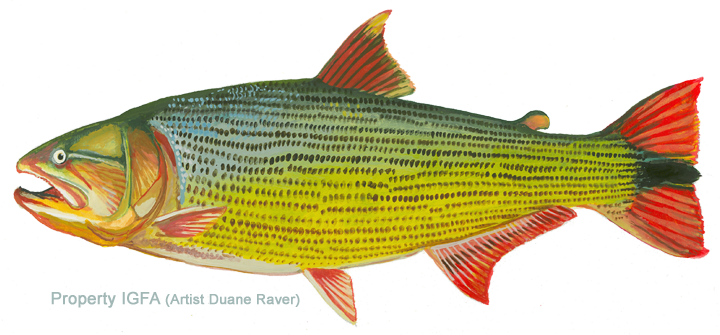Game Fish Identification Reference Guides
Dorado
(Salminus brasiliensis)
(Salminus brasiliensis)

(Cuvier, 1816) (syn. S. maxillosus); CHARACIDAE FAMILY
This South American fish is found in the rivers of the São Francisco River system of Brazil, the Paraguay and Uruguay River systems, the Magdalena River system of Colombia and the Paran River of Argentina. It also occurs in the Rio de la Plata and has been introduced into the Paralba and Doce rivers of Brazil. It apparently does not occur in the Amazon and Orinoco basins as once believed. This misconception, widespread in literature, appears to be due to confusion with another species that occurs in the Amazon and Orinoco and which is called dorado in that region, but is actually the piraba.
The name dorado is Spanish for “golden.” The same name is used in Spanish language areas of the Caribbean for the dolphin (Coryphaena hippurus). Both species are predominantly golden in color with blue, orange, and yellow overtones or highlights. There is a shock of blue in the center of the tail. In general body shape the dorado greatly resembles a salmon with a golden body and a somewhat scalloped tail. The position and shape of the fins is also the same as in the salmons. There is an adipose fin after the dorsal fin, and an axillary process. The head looks like a bluefish's head, machine tooled in gold with blue highlights. The lower jaw is stout and strong, and there is a double row of teeth, the outer row consisting of strong canines.
Unlike the salmons, it does not die after spawning and never ventures beyond the river mouth into the open sea. It is a good food fish and an excellent sport fish. It is powerful and huge, and its mouth has been described as a “steel trap”
This South American fish is found in the rivers of the São Francisco River system of Brazil, the Paraguay and Uruguay River systems, the Magdalena River system of Colombia and the Paran River of Argentina. It also occurs in the Rio de la Plata and has been introduced into the Paralba and Doce rivers of Brazil. It apparently does not occur in the Amazon and Orinoco basins as once believed. This misconception, widespread in literature, appears to be due to confusion with another species that occurs in the Amazon and Orinoco and which is called dorado in that region, but is actually the piraba.
The name dorado is Spanish for “golden.” The same name is used in Spanish language areas of the Caribbean for the dolphin (Coryphaena hippurus). Both species are predominantly golden in color with blue, orange, and yellow overtones or highlights. There is a shock of blue in the center of the tail. In general body shape the dorado greatly resembles a salmon with a golden body and a somewhat scalloped tail. The position and shape of the fins is also the same as in the salmons. There is an adipose fin after the dorsal fin, and an axillary process. The head looks like a bluefish's head, machine tooled in gold with blue highlights. The lower jaw is stout and strong, and there is a double row of teeth, the outer row consisting of strong canines.
Unlike the salmons, it does not die after spawning and never ventures beyond the river mouth into the open sea. It is a good food fish and an excellent sport fish. It is powerful and huge, and its mouth has been described as a “steel trap”












